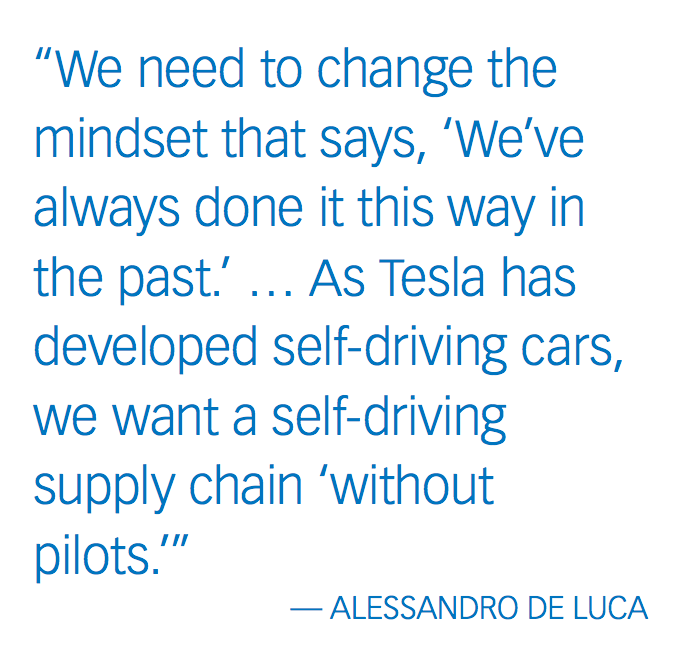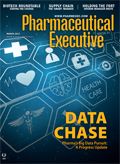Setting Sights on the Smart Supply Chain
Amid the push for a more intelligent and predictive supply chain, is it imperative for pharma companies to advance with their supply chain digitization strategies now-or is there still time to “wait and see?”
Amid the push for a more intelligent and predictive supply chain-focused on digitization strategies-life sciences companies are looking to keep pace. Overcoming challenges in mindset and culture may be the biggest hurdles in this process transformation.
As the everyday world becomes increasingly engaged with connected devices-from Fitbits and Apple Watches to smart refrigerators and HAPIforks-and high-tech industries like electronics and banking continue to advance their operations with cyber physical systems and cognitive computing, the shift to full digitization is drawing the pharma supply chain into its inevitable gravitational pull.
Digitization in Pharma, a PwC Strategy& report by Dr. Marcus Ehrhardt and Peter Behner, published in October 2016, states that the “first wave of the digital revolution focused on using technology platforms and data analytics to better understand customers… [T]he next wave of the digital revolution is about transforming operations.”
True to pharma’s conservative style, some supply chain practitioners are eyeing with a degree of apprehension this encroaching era of “Industry 4.0”-originally an initiative introduced by the German government to link resources, information, objects and people, and now a globally accepted term representing “the fourth industrial revolution.” Practices at the logistics end of the supply chain, for example, remain, somewhat resistant to digitization. As PartnerSave’s Alan Kennedy told Pharm Exec, pharma logistics is still “10 years behind in this area”; there is a lot of ground to be caught up. “The day-to-day reality for many in logistics is still one of traditional, paper-based systems,” he says. While there are valid reasons for this, and for other areas of pharma approaching Industry 4.0 with tentative steps, Ehrhardt and Behn’s report counters that such caution “is becoming a hindrance.”
For Ehrhardt, a leader in the life sciences strategy business within Strategy&, PwC’s strategy consulting group, digitization “holds tremendous potential in helping pharma companies transform their operations for improved supply chain performance and integrity.” He told Pharm Exec, “Today’s pharma supply chains are characterized by long lead and throughput times, relatively low utilization levels, high inventory, limited end-to-end visibility, etc., which all add to their cost. While at the same time complexity and price pressure is increasing significantly, calling for more agility and productivity in pharma operations.”
Digitization can help pharma companies address these challenges, says Ehrhardt. “Pharma plants or production lines, for example, typically experience high levels of downtime. Through digitization, this downtime can be reduced significantly. Production lines with sensors providing operations data paired with innovative software solutions and analytics, machine-to-machine communication and machine-learning algorithms allow for seamless processes, predictive maintenance, and automatic corrective actions. We already see this being applied in electronic plants or airplane turbines, or heavy equipment for oil and gas production. It’s already out there.”
The mindset challenge
The effort to realize this operational opportunity and successfully build a digital supply chain ecosystem requires a high degree of investment and a wide-ranging overhaul of supply chain processes, incorporating virtual supply chain control tools, cloud-based information architecture and a digitally enabled physical supply chain. But the necessary transformation that most commentators agree may be the hardest to achieve is a cultural one. Even Alessandro de Luca, chief information officer for the healthcare business sector of Merck KGaA, Darmstadt, Germany-a drugmaker at the forefront of digitizing its pharma supply chain-agrees that the biggest challenge is “mindset.” De Luca, previously the company’s head of global supply chain network operations, told Pharm Exec, “I keep repeating to everyone in my team and beyond that we need to change the mindset that says, ‘We’ve always done it this way in the past.’ This mindset is more of a challenge to supply chain digitization than the challenges coming from things like business processes, software development and technology.”
De Luca is, nonetheless, convinced that transformation of the supply chain is fundamental. “The supply chain of the future should fully rely on digital solutions,” he says. “Our vision is to have a self-driving supply chain powered by artificial intelligence. As Tesla has developed self-driving cars, we want a self-driving supply chain ‘without pilots.’” De Luca envisions an intelligent supply chain that automatically balances supply with demand, with demand forecasting systems based on historical forecasts and predictive algorithms. “The role of demand planner will evolve,” he says. “Instead you will have demand architects. Same for the supply side; this role will also evolve as supply will be totally automated. This will be the first step toward full digitization.”


For Kennedy, however, changing roles also equate to loss of jobs, especially at the logistics end. “There are social and internal consequences. We have a very fragmented, very conventional, very traditional industry when it comes to logistics, and here we are talking about cutting-edge technologies. Lots of people will see a downside to digitization, a loss of jobs, the loss of their own job.”
Kennedy points to a recent conference in China on Industry 4.0, where a speaker from the German-based logistics association BVL discussed the probability of dedicated jobs being replaced by robots or computers in the next few years. “He showed that freight forwarders have a 99% chance of losing their jobs because of new technologies,” says Kennedy. “There won’t be a need for them.”
De Luca agrees that “automation will definitely replace repetitive tasks in human activities.” But, he says, “those who have the agility to reinvent themselves will survive and be on the leading edge. This is why we believe in diversity in every sense, including a blend of younger people working with the older generation. At Merck KGaA, Darmstadt, Germany, we are hiring younger people, while investing significantly in training development for older ones, in order to build the required skill sets to implement the newest technological solutions. This is how the mindset change can happen faster.”
Regulation and security
For supply chain practitioners resistant to cultural change, however, the regulatory considerations surrounding digitization may only compound the overriding sense of caution. As Ehrhardt told Pharm Exec, the pharma industry historically has been cautious in adopting new technologies and making changes in its operations, due to the regulatory environment pharma companies operate in. Each change introduced in the production process of a product, whether it is going to be produced in a different manufacturing site or with different manufacturing equipment, have to be registered from a regulatory point of view for each affected product.
These regulatory aspects, of course, add hurdles and cost to the business case of operations changes and often create push-back especially for older products or smaller volume products. But Ehrhardt insists that regulation “is not a ‘stop sign’ to the digitization of operations.” As long as a company does not change the production process itself in a way that it may affect product quality, “it’s less of a problem,” he says. Putting sensors on a machine to monitor operations and ascertain how long it has been running, for example, “is not really changing the machine or production process per se. A lot of operations digitization can be achieved without the problems of re-registering a product.”
Kennedy, however, says that regulation presents “a conflict between individual companies and national needs.” Many of the far-reaching regulatory requirements in pharma “revolve around very decentralized, paper-based systems,” he says.
And changing that takes time. “The Luxembourg government, for example, launched the Single Window for Logistics (SWL) program in 2013/2014,” Kennedy explains. “This is well under way but it’s not programmed to finish until some time in the 2020s. Individual companies, however, may be looking to change their processes now, and therein lies the conundrum.”
Similarly, for Kennedy, the Declaration of Amsterdam, which is aimed at removing all the legislative barriers to rolling out vehicle automation, is “a good example of the global, regulatory picture being far removed from the experience of ‘the little guy.’”
According to Ehrhardt, certain aspects of digitization are probably easier for smaller companies, as they typically have less complexity overall. “If you are a top-five global pharma company, it is a lot more difficult and a bigger commitment to say, ‘Let’s do digitization and roll it out straight away,’” he says. “Pharma companies should approach the digitization of their operations in waves, starting with a pilot project, and then start to roll it out to sites, different regions countries, business partners and ultimately to the whole supply chain. This is what we’re starting to see. No one is really implementing broadly at this point, we’re still at the experimental stage.”
Even for those wholeheartedly on board with the concept of supply chain transformation, the increased security threat surrounding digitization presents a conspicuous challenge. As digital processes become more sophisticated, so do the hackers and cyber criminals. Kennedy notes that “there will soon be more than 100 trillion sensors collecting data in the world, not all connected but increasingly they will be interconnected. The repercussions of something going wrong in a supply chain is exponentially compounded with an Internet of Things (IoT) approach.”
Of course, there are risks and concerns: Could someone try to hack into your digital operations network, either to obtain information for competitive advantage or to engage in criminal blackmail activity? Could someone try to take control of your production? “These are not scenarios that are unthinkable,” says Ehrhardt. However, he adds, “There are very similar risks in the financial sector, and they are always striving to find solutions. I don’t see these risks as a showstopper. It does take effort and money to secure systems, of course, but whatever you choose to do, I don’t see that anyone will stop this wave of digitization.”
De Luca asserts that, of course, pharma cannot allow any security or quality failures. “We cannot afford any breach, whether that relates to patient privacy, drug safety, quality, or production capabilities.” With safety, quality and efficacy factors always in mind, he says, “Pharma is always going to safely learn behind some of the other industries in terms of supply chain digitization, and is likely to be on the following path rather than the leading path. But with digital technology it can catch up faster.”
Digitize or die?
From Kennedy’s perspective of caution, the obstacles facing supply chain digitization “aren’t issues that can’t be resolved, but they are issues that have to be resolved.” Key to making it work, he believes, is collaboration. “The reality is that companies have got to be much more prepared to work in cooperation,” he says. “We’ve seen this in the retail industry. Some of the big retail suppliers are now doing consolidated deliveries. For this, they all had to agree, which was almost counter-intuitive to them because they are all essentially in competition. But it’s the right solution. There shouldn’t, for example, be two half-full trucks heading toward the same supermarket to deliver their loads. Some industries have realized this, but this hasn’t happened on the pharma side.”
If pharma does not adopt such collaborative approaches, says Kennedy, digitization will be “a very piecemeal, long-haul adoption.” He believes that, for some of the smaller players at least, the best solution at this point is to “sit on the fence.”
“There is an air in some quarters of supply chain digitization being the next dot.com bubble,” Kennedy says. “It has such huge potential, but maybe it is not the right thing for everyone to do. Make the wrong decisions now and a company could be bearing some very serious consequences for their bottom line in the future.”
De Luca agrees that a new perspective on partnership is essential. Merck KGaA, Darmstadt, Germany is “now looking at hardware and software providers not as providers but as real partners,” de Luca says. “We want to join with a few selected partners to develop tailored solutions in terms of technology, and together we can discover how to leverage the technology to drive our business better.”
De Luca’s commitment to full supply chain digitization will see Merck KGaA, Darmstadt, Germany achieve it, he believes, “in the next 18-24 months.” The wider pharma industry, he says, will get there in the next three to five years.
While Ehrhardt would not yet go so far as to say “digitize or die!”, he agrees that the next three to five years will see a lot of changes in the overall operations space in pharma. He warns that if companies don’t do anything, or fail to start setting up their organizations to build digital capabilities, it will be difficult for them to “jump on the bandwagon.”
“Implementing new technology and, thus, transforming global operations is a complex task; it cannot be done in six months,” Ehrhardt says. “That’s why we urge leading players who want to stay at the forefront in the future to embrace it.”
Those companies that seize the initiative, he adds, can give themselves a sustainable competitive advantage, operate with greater agility, cost-efficiency, and control, and ultimately provide better care for patients.
Julian Upton is Pharm Exec’s Online and European Editor. He can be reached at julian.upton@ubm.com


.png&w=3840&q=75)

.png&w=3840&q=75)



.png&w=3840&q=75)



.png&w=3840&q=75)

















